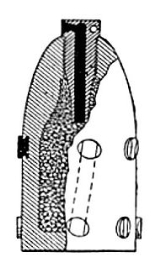
La Hitte system
Encyclopedia
The La Hitte system named after the French general Ducos, Count de La Hitte
, was an artillery system designed in March 1858 to implement rifled muzzle-loading guns in the French Army
.
("Directeur de l'atelier de précision") who had developed the principle and General de La Hitte ("Président du Comité d'Artillerie") who had implemented it:
in Italy
. These guns were a considerable improvement over the previous smooth-bore guns which had been in use. They were able to shoot at 3,000 meters either regulars shells, ball-loaded shells or grapeshot. They appear to have been the first case of usage of rifled cannons on a battlefield.
The system was muzzle-loading, and the shells could only be exploded at two set distances. The shell, based on the 1847 invention of Captain Tamisier, were oval-shaped and had small protrusions to follow the grooves of the bore. Previous guns, such as the Canon obusier de 12
were rifled to accommodate the system. The system included newly rifled siege guns of 12, 16 and 24, new field guns of 4 and 12, new siege guns of 12 and 24, and a mountain gun of 4.
, now fired a 11.5 kg shell compared to the Napoleon's 4.1 kg projectile.
and the development of breech-loading rifled guns.
Jean-Ernest Ducos de La Hitte
Jean Ernest Ducos de La Hitte, Viscount, was born on 5 September 1789 in Bessières , and died on 22 September 1878 in Gragnague . He was a French major general, Senator, Foreign Minister, and the implementer of the La Hitte system of rifled guns in 1858.He entered the Ecole Polytechnique in 1807...
, was an artillery system designed in March 1858 to implement rifled muzzle-loading guns in the French Army
French Army
The French Army, officially the Armée de Terre , is the land-based and largest component of the French Armed Forces.As of 2010, the army employs 123,100 regulars, 18,350 part-time reservists and 7,700 Legionnaires. All soldiers are professionals, following the suspension of conscription, voted in...
.
Conception
The La Hitte system was developed through the collaborative work of Lieutenant-colonel Treuille de BeaulieuAntoine Treuille de Beaulieu
Antoine Hector Thésée Treuille de Beaulieu was a French General of the 19th century, who developed the concept of rifled guns in the French Army. He studied the subject of rifling between 1840 and 1852. Following a request by Napoleon III in 1854 to develop such a weapon, the de Beaulieu system...
("Directeur de l'atelier de précision") who had developed the principle and General de La Hitte ("Président du Comité d'Artillerie") who had implemented it:
Specifications
The new rifled guns were used from 1859 during the Franco-Austrian WarFranco-Austrian War
Franco-Austrian War can refer to any of a number of wars between France and Austria:*Part of the Thirty Years' War *The Franco-Dutch War *The War of the Grand Alliance *The War of the Spanish Succession...
in Italy
Italy
Italy , officially the Italian Republic languages]] under the European Charter for Regional or Minority Languages. In each of these, Italy's official name is as follows:;;;;;;;;), is a unitary parliamentary republic in South-Central Europe. To the north it borders France, Switzerland, Austria and...
. These guns were a considerable improvement over the previous smooth-bore guns which had been in use. They were able to shoot at 3,000 meters either regulars shells, ball-loaded shells or grapeshot. They appear to have been the first case of usage of rifled cannons on a battlefield.
The system was muzzle-loading, and the shells could only be exploded at two set distances. The shell, based on the 1847 invention of Captain Tamisier, were oval-shaped and had small protrusions to follow the grooves of the bore. Previous guns, such as the Canon obusier de 12
Canon obusier de 12
The Canon obusier de 12 , also known as the "Canon de l’Empereur" was a type of canon-obusier developed by France in 1853...
were rifled to accommodate the system. The system included newly rifled siege guns of 12, 16 and 24, new field guns of 4 and 12, new siege guns of 12 and 24, and a mountain gun of 4.
Change in meaning of gun designations
Note that with the introduction of rifling and elongated shells replacing the old roundshot, guns could now fire projectiles weighing nearly twice the previous weight possible for a given bore (calibre). The rifling gave a far greater range for a given propellant charge, hence a minimal increase in gunpowder was needed for the heavier shells. While the La Hitte guns retained the traditional 4 designation, the number now approximated to kg rather than the livre (French pound) as previously. Hence the Canon de campagne de 4 La Hitte fired a shell weighing nearly 4 kg. Similarly, the Canon de 12 La Hitte, basically a rifled 12-cm NapoleonCanon obusier de 12
The Canon obusier de 12 , also known as the "Canon de l’Empereur" was a type of canon-obusier developed by France in 1853...
, now fired a 11.5 kg shell compared to the Napoleon's 4.1 kg projectile.
Obsolescence
The La Hitte system would be superseded in 1870 with the work of Jean-Baptiste Verchère de ReffyeJean-Baptiste Verchère de Reffye
Jean-Baptiste Verchère de Reffye was a French artillery general of the 19th century, and superintendent of the works at Meudon. He was a former ordnance officer for Napoleon III...
and the development of breech-loading rifled guns.

